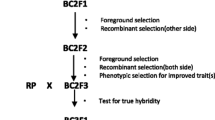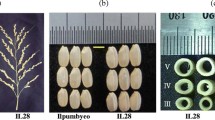Abstract
Development of quantitative trait loci (QTL) near isogenic lines is a crucial step to QTL isolation using the strategy of map-based cloning. In this study, a recombinant inbred line (RIL) population derived from two indica rice varieties, Zhenshan 97 and HR5, was employed to map QTL for spikelets per panicle (SPP). One major QTL (qSPP7) and three minor QTL (qSPP1, qSPP2 and qSPP3) were identified on chromosomes 7, 1, 2 and 3, respectively. Four sets of near isogenic lines (NILs) BC4F2 targeted for the four QTL were developed by following a standard procedure of consecutive backcross, respectively. These QTL were not only validated in corresponding NILs, but also explained amounts of phenotypic variation with much larger LOD scores compared with those identified in RILs. SPP in the four QTL-NILs expressed bimodal or discontinuous distributions and followed the expected segregation ratio of single Mendelian factor by progeny test. Finally, qSPP1, qSPP2, qSPP3 and qSPP7 were respectively mapped to a locus, 0.5 cM from MRG2746, 0.6 cM from MRG2762, 0.8 cM from RM49 and 0.7 cM from MRG4436, as co-dominant markers on the basis of progeny tests. These results indicate no matter how small effect minor QTL is, QTL may still express the characteristics of single Mendelian factor in NILs and isolation of minor QTL will be possible using high quality NILs. Pyramiding these QTL into a variety will largely enhance rice grain yield.



Similar content being viewed by others
References
Alpert K, Tanksley S (1996) High-resolusion mapping and isolation of a yeast artificial chromosome contig containing fw2.2: a major fruit weight quantitative trait locus in tomoto. PNAS 93:15503–15507
Ashikari M, Sakakibara H, Lin S, Yamamoto T, Takashi T, Nishimura A, Angeles ER, Qian Q, Kitano H, Matsuoka M (2005) Cytokinin oxidase regulates rice grain production. Science 29:741–745
Chu ZH, Fu BY, Yang H, Xu CG LIZK, Sanchez A, Park YJ, Bennetzen JL, Zhang QF, Wang SP (2005) Targeting xa13, a recessive gene for bacterial blight resistance in rice. Theor Appl Genet 112:455–461
Churchill GA, Doerge RW (1994) Empirical threshold values for quantitative trait mapping. Genetics 138:963–971
Darvasi A, Weinreb A, Minke V, Wellert JI, Soller M (1993) Detecting marker-QTL linkage and estimating QTL gene effect and map location using a saturated genetic map. Genetics 134:943–951
Fan CC, Xing YZ, Mao HL, Lu TT, Han B, Xu CG, Li XH, Zhang QF (2006) GS3, a major QTL for grain length and weight and minor QTL for grain width and thickness in rice, encodes a putative transmembrane protein. Theor Appl Genet 112:1164–1171
Ishimaru K, Ono K, Kashiwagi T (2004) Identification of a new gene controlling plant height in rice using the candidate-gene strategy. Planta 218:388–395
Lander ES, Botsein D (1989) Mapping Mendelian factors underlying quantitative traits using RFLP linkage maps. Genetics 121:185–199
Li YL, Niu SZ, Dong YB, Cui DQ, Wang YZ, Liu YY, Wei MG (2007) Identification of trait-improving quantitative trait loci for grain yield components from a dent corn inbred line in an advanced backcross BC2F2 population and comparison with its F2:3 population in popcorn. Theor Appl Genet 115:129–140
Lincoln SE, Daley M, Lander E (1992) Constructing genetic maps with MAPMAKER/EXP 3.0. Whitehead Institute Technical Report, 3rd edn. Whitehead Institute, Cambridge
Lincoln SE, Daly MJ, Lander ES (1993) Mapping genes controlling quantitative traits with MAPMAKER/QTL1.1: a tutorial and reference manual, 2nd edn. Whitehead Institute Technical Report, Cambridge
Lu C, Shen Z, Tan Z, Xu Y, He P, Chen Y, Zhu L (1996) Comparative mapping of QTL for agronomic traits of rice across environments using a doubled haploid population. Theor Appl Genet 93:1211–1217
McCouch SR, Teytelman L, Xu Y, Lobos KB, Clare K, Walton M, Fu B, Maghirang R, Li Z, Xing Y, Zhang Q, Kono I, Yano M, Fjellstrom R, DeClerck G, Schneider D, Cartinhour S, Ware D, Stein L (2002) Development and mapping of 2, 240 new SSR markers for rice (Oryza sativa L.). DNA Res 9:199–207
Mei HW, Xu JL, Li ZK, Yu XQ, Guo LB, Wang YP, Ying CS, Luo LJ (2006) QTL influencing panicle size detected in two reciprocal introgressive line (IL) populations in rice (Oryza sativa L.). Theor Appl Genet 112:648–656
Monna L, Kitazawa N, Yoshino R, Suzuki J, Masuda H, Maehara Y (2002) Positional cloning of rice semidwarfing gene, sd-1: rice “green revolution gene” encodes a mutant enzyme involvedin gibberellin synthesis. DNA Res 9:11–17
Murray MG, Thompson WF (1980) Rapid isolation of highmolecular-weight plant DNA. Nucleic Acids Res 8:4321
Sasaki A et al (2002) Green revolution: a mutant gibberellin-synthesis gene in rice—new insight into the rice variant that helped to avert famine over thirty years ago. Nature 416:701–702
Septiningsih EM, Prasetiyono J, Lubis E, Tai TH, Tjubaryat T, Moeljopawiro S, McCouch SR (2003) Identification of quantitative trait loci for yield and yield components in an advanced backcross population derived from the Oryza sativa variety IR64 and the wild relative O. rufipogon. Theor Appl Genet 107:1419–1432
Song XJ, Huang W, Shi M, Zhu MZ, Lin HX (2007) A QTL for rice grain width and weight encodes a previously unknown RING-type E3 ubiquitin ligase. Nat Genet 39(5):623–630
Spielmeyer W, Ellis MH, Chandler PM (2002) Semidwarf (sd-1), “green revolution” rice, contains a defective gibberellin 20-oxidase gene. PNAS 99:9043–9048
Takahashi Y, Shomura A, Sasaki T, Yano M (2001) Hd6, a rice quantitative trait locus involved in photoperiod sensitivity, encodes the a subunit of protein kinase CK2. PNAS 98:7922–7927
Temnykh S, Park WD, Ayres N, Cartihour S, Hauck N, Lipovich L, Cho YG, Ishii T, McCouch SR (2000) Mapping and genome organization of microsatellite sequences in rice (Oryza sativa L.). Theor Appl Genet 100:697–712
Temnykh S, Declerck G, Luashova A, Lipovich L, Cartinhour S, McCouch S (2001) Computational and experimental analysis of microsatellites in rice (Oryza sativa L.): frequency, length variation, transposon associations, and genetic marker potential. Genome Res 11:1441–1452
Wang SG, Zeng ZB (2003) Windows QTL Cartographer v2.0 Bioinformatics Research Center, North Carolina State Universit
Wang GW, He YQ, Xu CG, Zhang QF (2005) Identification and confirmation of three neutral alleles conferring wide compatibility in inter-subspecific hybrids of rice (Oryza sativa L.) using near-isogenic lines. Theor Appl Genet 111:702–710
Xiao J, Li J, Yuan L, Tanksley SD (1996) Identification of QTL affecting traits of agronomic importance in a recombinant inbred population derived from a subspecific rice cross. Theor Appl Genet 92:230–244
Xing YZ, Tan YF, Hua JP, Sun XL, Xu CG, Zhang QF (2002) Characterization of the main effects, epistatic effects and their environmental interactions of QTL on the genetic basis of yield traits in rice. Theor Appl Genet 105:248–257
Xing YZ, Tang WJ, Xue WY, Xu CG, Zhang QF (2008) Fine mapping of a major quantitative trait loci, qSSP7, controlling the number of spikelets per panicle as a single Mendelian factor in rice. Theor Appl Genet 116:789–796
Xiong LZ, Liu KD, Dai X, Xu CG, Zhang QF (1999) Identification of genetic factors controlling domestication-related traits of rice using an F2 population of a cross between Oryza sativa and O. rufipogon. Theor Appl Genet 98:243–251
Xue W, Xing Y, Weng X, Zhao Y, Tang W, Wang L, Zhou H, Yu S, Xu C, Li X, Zhang Q (2008) Natural variation in Ghd7 is an important regulator of heading date and yield potential in rice. Nat Genet 40:761–767
Yamamoto T, Kubiki Y, Lin SY, Sasaki T, Yano M (1998) Fine mapping of quantitative trait loci Hd-1, Hd-2 and Hd-3, controlling heading date of rice, as single Mendelian factors. Theor Appl Genet 97:37–42
Yamamoto T, Lin H, Sasaki T, Yano M (2000) Identification of heading date quantitative trait locus Hd6 and characterization of its epistatic interactions with Hd2 in rice using advanced backcross progeny. Genetics 154:885–891
Yi B, Chen Y, Lei S, Tu J, Fu T (2006) Fine mapping of the recessive genic male-sterile gene (Bnms1) in Brassica napus L. Theor Appl Genet 113:643–650
Yu SB, Li JX, Xu CG, Tan YF, Gao YJ, Li XH, Zhang QF (1997) Importance of epistasis as the genetic basis of heterosis in an elite rice hybrid. Proc Natl Acad Sci 94:9226–9231
Zhang ZH, Li P, Wang LX, Hua ZL, Zhu LH, Ying-Guo Zhu YG (2004) Genetic dissection of the relationships of biomass production and partitioning with yield and yield related traits in rice. Plant Sci 167:1–8
Zhang YS, Luo LJ, Xu CG, Zhang QF, Xing YZ (2006) Quantitative trait loci for panicle size, heading date and plant height co-segregating in trait-performance derived near-isogenic lines of rice (Oryza sativa). Theor Appl Genet 113:361–368
Zhuang J, Lin H, Lu J, Qian H (1997) Analysis of QTL × environment interaction for yield components and plant height in rice. Theor Appl Genet 95:799–808
Acknowledgments
This work was supported in part by grants from the National Key Program on Basic Research and Development of China and National Natural Science Foundation of China.
Author information
Authors and Affiliations
Corresponding author
Additional information
Communicated by T. Sasaki.
Rights and permissions
About this article
Cite this article
Zhang, Y., Luo, L., Liu, T. et al. Four rice QTL controlling number of spikelets per panicle expressed the characteristics of single Mendelian gene in near isogenic backgrounds. Theor Appl Genet 118, 1035–1044 (2009). https://doi.org/10.1007/s00122-008-0960-7
Received:
Accepted:
Published:
Issue Date:
DOI: https://doi.org/10.1007/s00122-008-0960-7




